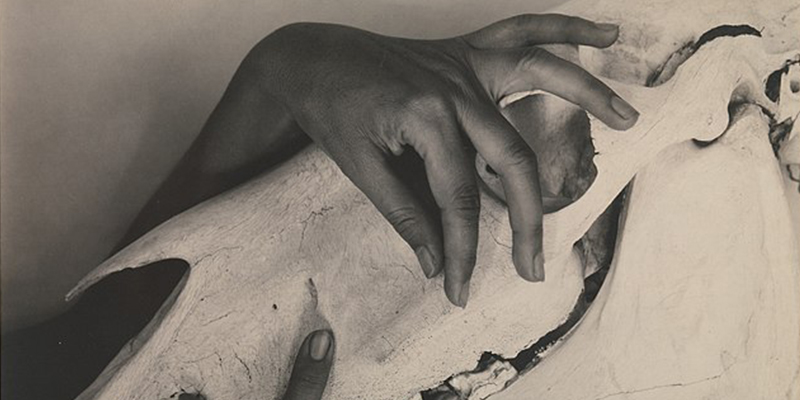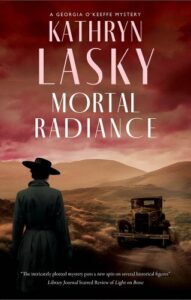The burden, and I should say the responsibility of writing about a real historical figure, is formidable. Do you depict that person warts and all? How indeed do you reveal those warts without violating your character, but rather make the flaws an interesting part of their personality? This is a challenge I had to meet head on when I set out to write my Georgia O’Keeffe mysteries. I knew about her as a painter as the rest of the world does. But what in her character or her work as a painter would even suggest she might make a good amateur sleuth?
Actually, my research began with an art exhibition at the Peabody Essex Museum in Salem, Massachusetts that focused not on her paintings but her “things”—her clothing mostly. She was an expert seamstress and sewed many of her own clothes. I fell in love with one cream colored dress that had miniscule pleats that made up the bodice. I put that dress in the first book I wrote featuring Georgia, Light On Bone. One thinks of O’Keeffe’s paintings as great swathes of color, broad brush strokes but the stitching on this dress is just the opposite of broad brushstrokes. It is painstakingly delicate. The detailing is exquisite, the stitches almost microscopic. In short, she was alert to the infinitesimal that others might miss. For her, the Sherlock Holmes magnifying glass would be redundant.
In addition to the clothes she made, she had a fairly large collection of Japanese kimonos. These kimonos in a sense spoke largely about her aesthetic which was sleek and simple. But there were also, jeans, sneakers, and a well-worn pair of brown leather lace up boots that she used for tromping around in the desert.
Issey Miyake, the famous Japanese clothing designer, in 1983 declared the painter his muse. “Georgia O’Keeffe. For the first time, I’m designing clothes with one person in mind. And I’m planning to send them to her when they’re ready.”
But perhaps the greatest example of her refined sensibilities is her house in Abiquiu, New Mexico. Her dining table was a plywood plank on sawhorses. On a small table by an easy chair there was a dish of rattles she collected from rattlesnakes she had encountered on her walks out in the desert, and killed if they threatened her. There were also, the bones that she searched for that became a central subject of so many of her paintings. In short, no clutter, no tchotchkes, nothing distracting. She could keep her focus on form, pattern and construction. How things fit together.
As I have said countless times to people, when you come back from seeing the Abiquiu house, you simply want to throw out everything in your own house. But then you realize it wouldn’t work, for it is the New Mexico light that brings it all together. She decorated the house in an active partnership with the desert light.
But these are all the material things that spoke so directly to her aesthetic. What about her thinking? Her beliefs beyond the material? How did she think and handle her complex relationship with her husband Alfred Stieglitz who was serially unfaithful to her? Perhaps the one act she never forgave was when he forced her to have an abortion.
Although I never found anything in her writing that directly mentioned the abortion, I did find this letter to Stieglitz after one of her early trips to the southwest.
There is much life in me — when it was always checked in moving toward you — I realized it would die if it could not move toward something … I chose coming away because here at least I feel good — and it makes me feel I am growing very tall and straight inside — and very still — Maybe you will not love me for it — but for me it seems to be the best thing I can do for you — I hope this letter carries no hurt to you — It is the last thing I want to do in the world.
So, it was by reading her letters to Stieglitz and those she wrote to Anita Pollitzer, another artist and friend, who introduced her to Stieglitz that I discovered her voice, and some of her deepest passions. It is a quiet yet dazzling voice. It is a voice that I felt was the essence of Georgia O’Keeffe.
I have written many novels that feature historical figures. Although these are fictional stories, I always want to stay true to the character of that person. I think of myself as an explorer of feelings, buried emotions and not simply events in their lives, but how these events might impact their lives and how they would think about them. And this is what fed into Georgia’s eccentric skills as an amateur detective. There is an array of feelings and emotions to be explored in the life of O’Keeffe. Perhaps first and foremost those feelings for the desert and her regrets of never having a child. But there are also her political beliefs and the growing threat of the second world war.
Perhaps the best part of writing about an historical figure is for me the ‘historical’ part. My book Light on Bone, and the second one, Mortal Radiance, are both set in the 1930s. The build up toward World War 2 is beginning. Therefore, I find myself having to take meticulous care on a range on seemingly obscure questions as I explore that era and put facts in the book. What year were the ice cream treats Eskimo pies invented? Did they have electro cardiograms in the 1930’s? When was penicillin developed? The OSS morphed into the CIA in the 1940s. How did that happen? When and where in our country did the German American Bund emerge. What were the ties between the Duke and the Duchess of Windsor and Nazis?
But perhaps one of the most fascinating things I had to explore was a perceptual phenomenon that Georgia O’Keeffe had known as Synesthesia. Synesthesia is a perceptual experience in which stimulation in one sensory pathway triggers another experience in a second pathway. This is a perfect talent for a visionary detective to possess. And it’s not fiction! Georgia was a great listener to classical music. So, I might think when I see one of her paintings what music might she have been listening to that inspired the painting of The Grey Hills—was it Pablo Casals? Or perhaps something more tumultuous, Mahler Symphony number 9? For me Georgia O’Keeffe is an ultimate and compelling enigma and that was why I chose to write about her. And in doing so I am determined to remain faithful to the fiction of this character—Georgia Totto O’Keeffe.
***


















